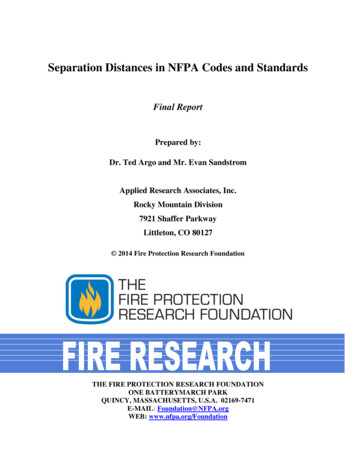
Transcription
Sinkhorn Distances:Lightspeed Computation of Optimal TransportMarco CuturiGraduate School of Informatics, Kyoto Universitymcuturi@i.kyoto-u.ac.jpAbstractOptimal transport distances are a fundamental family of distances for probabilitymeasures and histograms of features. Despite their appealing theoretical properties, excellent performance in retrieval tasks and intuitive formulation, their computation involves the resolution of a linear program whose cost can quickly become prohibitive whenever the size of the support of these measures or the histograms’ dimension exceeds a few hundred. We propose in this work a new familyof optimal transport distances that look at transport problems from a maximumentropy perspective. We smooth the classic optimal transport problem with anentropic regularization term, and show that the resulting optimum is also a distance which can be computed through Sinkhorn’s matrix scaling algorithm at aspeed that is several orders of magnitude faster than that of transport solvers. Wealso show that this regularized distance improves upon classic optimal transportdistances on the MNIST classification problem.1 IntroductionChoosing a suitable distance to compare probabilities is a key problem in statistical machine learning. When little is known on the probability space on which these probabilities are supported, variousinformation divergences with minimalistic assumptions have been proposed to play that part, amongwhich the Hellinger, χ2 , total variation or Kullback-Leibler divergences. When the probabilityspace is a metric space, optimal transport distances (Villani, 2009, §6), a.k.a. earth mover’s (EMD)in computer vision (Rubner et al., 1997), define a more powerful geometry to compare probabilities.This power comes, however, with a heavy computational price tag. No matter what the algorithmemployed – network simplex or interior point methods – the cost of computing optimal transportdistances scales at least in O(d3 log(d)) when comparing two histograms of dimension d or twopoint clouds each of size d in a general metric space (Pele and Werman, 2009, §2.1).In the particular case that the metric probability space of interest can be embedded in Rn and n issmall, computing or approximating optimal transport distances can become reasonably cheap. Indeed, when n 1, their computation only requires O(d log d) operations. When n 2, embeddingsof measures can be used to approximate them in linear time (Indyk and Thaper, 2003; Grauman andDarrell, 2004; Shirdhonkar and Jacobs, 2008) and network simplex solvers can be modified to runin quadratic time (Gudmundsson et al., 2007; Ling and Okada, 2007). However, the distortions ofsuch embeddings (Naor and Schechtman, 2007) as well as the exponential increase of costs incurredby such modifications as n grows make these approaches inapplicable when n exceeds 4. Outside ofthe perimeter of these cases, computing a single distance between a pair of measures supported bya few hundred points/bins in an arbitrary metric space can take more than a few seconds on a singleCPU. This issue severely hinders the applicability of optimal transport distances in large-scale dataanalysis and goes as far as putting into question their relevance within the field of machine learning,where high-dimensional histograms and measures in high-dimensional spaces are now prevalent.1
We show in this paper that another strategy can be employed to speed-up optimal transport, and evenpotentially define a better distance in inference tasks. Our strategy is valid regardless of the metriccharacteristics of the original probability space. Rather than exploit properties of the metric probability space of interest (such as embeddability in a low-dimensional Euclidean space) we choose tofocus directly on the original transport problem, and regularize it with an entropic term. We arguethat this regularization is intuitive given the geometry of the optimal transport problem and has,in fact, been long known and favored in transport theory to predict traffic patterns (Wilson, 1969).From an optimization point of view, this regularization has multiple virtues, among which that ofturning the transport problem into a strictly convex problem that can be solved with matrix scalingalgorithms. Such algorithms include Sinkhorn’s celebrated fixed point iteration (1967), which isknown to have a linear convergence (Franklin and Lorenz, 1989; Knight, 2008). Unlike other iterative simplex-like methods that need to cycle through complex conditional statements, the executionof Sinkhorn’s algorithm only relies on matrix-vector products. We propose a novel implementationof this algorithm that can compute simultaneously the distance of a single point to a family of pointsusing matrix-matrix products, and which can therefore be implemented on GPGPU architectures.We show that, on the benchmark task of classifying MNIST digits, regularized distances performbetter than standard optimal transport distances, and can be computed several orders of magnitudefaster.This paper is organized as follows: we provide reminders on optimal transport theory in Section 2,introduce Sinkhorn distances in Section 3 and provide algorithmic details in Section 4. We followwith an empirical study in Section 5 before concluding.2 Reminders on Optimal TransportTransport Polytope and Interpretation as a Set of Joint Probabilities In what follows, h·, ·istands for the Frobenius dot-product. For two probability vectors r and c in the simplex Σd : {x Rd : xT 1d 1}, where 1d is the d dimensional vector of ones, we write U (r, c) for the transportpolytope of r and c, namely the polyhedral set of d d matrices,U (r, c) : {P Rd d P 1d r, P T 1d c}. U (r, c) contains all nonnegative d d matrices with row and column sums r and c respectively.U (r, c) has a probabilistic interpretation: for X and Y two multinomial random variables takingvalues in {1, · · · , d}, each with distribution r and c respectively, the set U (r, c) contains all possiblejoint probabilities of (X, Y ). Indeed, any matrix P U (r, c) can be identified with a joint probability for (X, Y ) such that p(X i, Y j) pij . We define the entropy h and the Kullback-Leiblerdivergences of P, Q U (r, c) and a marginals r Σd ash(r) dXi 1ri log ri ,h(P ) dXpij log pij ,KL(P kQ) Xiji,j 1pij logpij.qijOptimal Transport Distance Between r and c Given a d d cost matrix M , the cost of mappingr to c using a transport matrix (or joint probability) P can be quantified as hP, M i. The problemdefined in Equation (1)(1)dM (r, c) : min hP, M i.P U(r,c)is called an optimal transport (OT) problem between r and c given cost M . An optimal table P for this problem can be obtained, among other approaches, with the network simplex (Ahuja et al.,1993, §9). The optimum of this problem, dM (r, c), is a distance between r and c (Villani, 2009,§6.1) whenever the matrix M is itself a metric matrix, namely whenever M belongs to the cone ofdistance matrices (Avis, 1980; Brickell et al., 2008):M {M Rd d: i, j d, mij 0 i j, i, j, k d, mij mik mkj }. For a general matrix M , the worst case complexity of computing that optimum scales in O(d3 log d)for the best algorithms currently proposed, and turns out to be super-cubic in practice as well (Peleand Werman, 2009, §2.1).2
3 Sinkhorn Distances: Optimal Transport with Entropic ConstraintsEntropic Constraints on Joint Probabilities The following information theoretic inequality(Cover and Thomas, 1991, §2) for joint probabilities r, c Σd , P U (r, c), h(P ) h(r) h(c),is tight, since the independence table rcT (Good, 1963) has entropy h(rcT ) h(r) h(c). By theconcavity of entropy, we can introduce the convex setUα (r, c) : {P U (r, c) KL(P krcT ) α} {P U (r, c) h(P ) h(r) h(c) α} U (r, c).These two definitions are indeed equivalent, since one can easily check that KL(P krcT ) h(r) h(c) h(P ), a quantity which is also the mutual information I(XkY ) of two random variables(X, Y ) should they follow the joint probability P (Cover and Thomas, 1991, §2). Hence, the set oftables P whose Kullback-Leibler divergence to rcT is constrained to lie below a certain thresholdcan be interpreted as the set of joint probabilities P in U (r, c) which have sufficient entropy withrespect to h(r) and h(c), or small enough mutual information. For reasons that will become clear inSection 4, we call the quantity below the Sinkhorn distance of r and c:Definition 1 (Sinkhorn Distance). dM,α (r, c) : min hP, M iP Uα (r,c)Why consider an entropic constraint in optimal transport? The first reason is computational, and isdetailed in Section 4. The second reason is built upon the following intuition. As a classic resultof linear optimization, the OT problem is always solved on a vertex of U (r, c). Such a vertex isa sparse d d matrix with only up to 2d 1 non-zero elements (Brualdi, 2006, §8.1.3). From aprobabilistic perspective, such vertices are quasi-deterministic joint probabilities, since if pij 0,then very few probabilities pij ′ for j 6 j ′ will be non-zero in general. Rather than consideringsuch outliers of U (r, c) as the basis of OT distances, we propose to restrict the search for low costjoint probabilities to tables with sufficient smoothness. Note that this is equivalent to consideringthe maximum-entropy principle (Jaynes, 1957; Darroch and Ratcliff, 1972) if we were to maximizeentropy while keeping the transportation cost constrained.Before proceeding to the description of the properties of Sinkhorn distances, we note that Ferradanset al. (2013) have recently explored similar ideas. They relax and penalize (through graph-basednorms) the original transport problem to avoid undesirable properties exhibited by the original optima in the problem of color matching. Combined, their idea and ours suggest that many moresmooth regularizers will be worth investigating to solve the the OT problem, driven by either or bothcomputational and modeling motivations.Metric Properties of Sinkhorn Distances When α is large enough, the Sinkhorn distance coincides with the classic OT distance. When α 0, the Sinkhorn distance has a closed form andbecomes a negative definite kernel if one assumes that M is itself a negative definite distance, orequivalently a Euclidean distance matrix1 .Property 1. For α large enough, the Sinkhorn distance dM,α is the transport distance dM .Proof. Since for any P U (r, c), h(P ) is lower bounded by 21 (h(r) h(c)), we have that for αlarge enough Uα (r, c) U (r, c) and thus both quantities coincide. Property 2 (Independence Kernel). dM,0 rT M c. If M is a Euclidean distance matrix, dM,0 is anegative definite kernel and e tdM,0 , the independence kernel, is positive definite for all t 0.The proof is provided in the appendix. Beyond these two extreme cases, the main theorem of thissection states that Sinkhorn distances are symmetric and satisfy triangle inequalities for all possiblevalues of α. Since for α small enough dM,α (r, r) 0 for any r such that h(r) 0, Sinkhorndistances cannot satisfy the coincidence axiom (d(x, y) 0 x y holds for all x, y). However,multiplying dM,α by 1r6 c suffices to recover the coincidence property if needed.Theorem 1. For all α 0 and M M, dM,α is symmetric and satisfies all triangle inequalities.The function (r, c) 7 1r6 c dM,α (r, c) satisfies all three distance axioms.1 n, ϕ1 , · · · , ϕd Rn such that mij kϕi ϕj k22 . Recall that, in that case, M raised to power telement-wise, [mtij ], 0 t 1 is also a Euclidean distance matrix (Berg et al., 1984, p.78,§3.2.10).3
U (r, c)MP λmaxmachine-precisionlimitλ 0rcTλ Uα(r, c)PαPλPα argmin hP, M iP P argminhP, M iP P Uα (r,c)λP P U(r,c)argminhP, M i λ1 h(P )P U(r,c)Rd dFigure 1: Transport polytope U (r, c) and Kullback-Leibler ball Uα (r, c) of level α centeredaround rcT . This drawing implicitly assumes that the optimal transport P is unique. The Sinkhorndistance dM,α (r, c) is equal to hPα , M i, the minimum of the dot product with M on that ball. For αlarge enough, both objectives coincide, as Uα (r, c) gradually overlaps with U (r, c) in the vicinityof P . The dual-sinkhorn distance dλM (r, c), the minimum of the transport problem regularized byminus the entropy divided by λ, reaches its minimum at a unique solution P λ , forming a regularization path for varying λ from rcT to P . For a given value of α, and a pair (r, c) there existsλ [0, ] such that both dλM (r, c) and dM,α (r, c) coincide. dλM can be efficiently computed usingSinkhorn’s fixed point iteration (1967). Although the convergence to P of this fixed point iterationis theoretically guaranteed as λ , the procedure cannot work beyond a problem-dependentvalue λmax beyond which some entries of e λM are represented as zeroes in memory.The gluing lemma (Villani, 2009, p.19) is key to proving that OT distances are indeed distances. Wepropose a variation of this lemma to prove our result:Lemma 1 (Gluing Lemma With Entropic Constraint). Let α P0 and x, y, z Σd . Let P p qUα (x, y) and Q Uα (y, z). Let S be the d d defined as sik : j ijyjjk . Then S Uα (x, z).The proof is provided in the appendix. We can prove the triangle inequality for dM,α by using thesame proof strategy than that used for classic transport distances:Proof of Theorem 1. The symmetry of dM,α is a direct result of M ’s symmetry. Let x, y, z be threeelements in Σd . Let P Uα (x, y) and Q Uα (y, z) be two optimal solutions for dM,α (x, y) anddM,α (y, z) respectively. Using the matrix S of Uα (x, z) provided in Lemma 1, we proceed with thefollowing chain of inequalities:XX pij qjkXpij qjkdM,α (x, z) min hP, M i hS, M i mik (mij mjk )P Uα (x,z)yyjjjikijkXX qjk XXX pijpij qjkpij qjk mijmij pij mjk mjk qjkyjyjyjyjijiijkkjkXXmij pij mjk qjk dM,α (x, y) dM,α (y, z). ijjk4 Computing Regularized Transport with Sinkhorn’s AlgorithmWe consider in this section a Lagrange multiplier for the entropy constraint of Sinkhorn distances:For λ 0, dλM (r, c) : hP λ , M i, where P λ argmin hP, M i P U(r,c)1h(P ).λ(2)By duality theory we have that to each α corresponds a λ [0, ] such that dM,α (r, c) dλM (r, c)holds for that pair (r, c). We call dλM the dual-Sinkhorn divergence and show that it can be computed4
for a much cheaper cost than the original distance dM . Figure 1 summarizes the relationships between dM , dM,α and dλM . Since the entropy of P λ decreases monotonically with λ, computing dM,αcan be carried out by computing dλM with increasing values of λ until h(P λ ) reaches h(r) h(c) α.We do not consider this problem here and only use the dual-Sinkhorn divergence in our experiments.Computing dλM with Matrix Scaling Algorithms Adding an entropy regularization to the optimal transport problem enforces a simple structure on the optimal regularized transport P λ :Lemma 2. For λ 0, the solution P λ is unique and has the form P λ diag(u)K diag(v),where u and v are two non-negative vectors of Rd uniquely defined up to a multiplicative factor andK : e λM is the element-wise exponential of λM .Proof. The existence and unicity of P λ follows from the boundedness of U (r, c) and the strictconvexity of minus the entropy. The fact that P λ can be written as a rescaled version of K is a wellknown fact in transport theory (Erlander and Stewart, 1990, §3.3): let L(P, α, β) be the Lagrangianof Equation (2) with dual variables α, β Rd for the two equality constraints in U (r, c):X1pij log pij pij mij αT (P 1d r) β T (P T 1d c).L(P, α, β) λijFor any couple (i, j), ( L/ pij 0) pij e 1/2 λαi e λmij e 1/2 λβj . Since K isstrictly positive, Sinkhorn’s theorem (1967) states that there exists a unique matrix of the formdiag(u)K diag(v) that belongs to U (r, c), where u, v 0d . P λ is thus necessarily that matrix,and can be computed with Sinkhorn’s fixed point iteration (u, v) (r./Kv, c./K ′ u). Given K and marginals r and c, one only needs to iterate Sinkhorn’s update a sufficient numberof times to converge to P λ . One can show that these successive updates carry out iteratively theprojection of K on U (r, c) in the Kullback-Leibler sense. This fixed point iteration can be writtenas a single update u r./K(c./K ′ u). When r 0d , diag(1./r)K can be stored in a d d matrixK̃ to save one Schur vector product operation with the update u 1./(K̃(c./K ′ u)). This can beeasily ensured by selecting the positive indices of r, as seen in the first line of Algorithm 1.Algorithm 1 Computation of d [dλM (r, c1 ), · · · , dλM (r, cN )], using Matlab syntax.Input M, λ, r, C : [c1 , · · · , cN ].I (r 0); r r(I); M M (I, :); K exp( λM )u ones(length(r), N )/length(r);K̃ bsxfun(@rdivide, K, r) % equivalent to K̃ diag(1./r)Kwhile u changes or any other relevant stopping criterion dou 1./(K̃(C./(K ′ u)))end whilev C./(K ′ u)d sum(u. ((K. M )v)Parallelism, Convergence and Stopping Criteria As can be seen right above, Sinkhorn’s algorithm can be vectorized and generalized to N target histograms c1 , · · · , cN . When N 1 and Cis a vector in Algorithm 1, we recover the simple iteration mentioned in the proof of Lemma 2.When N 1, the computations for N target histograms can be simultaneously carried out by updating a single matrix of scaling factors u Rd Ninstead of updating a scaling vector u Rd . This important observation makes the execution of Algorithm 1 particularly suited to GPGPU platforms. Despite ongoing research in that field (Bieling et al., 2010) such speed ups have not been yetachieved on complex iterative procedures such as the network simplex. Using Hilbert’s projectivemetric, Franklin and Lorenz (1989) prove that the convergence of the scaling factor u (as well as v)is linear, with a rate bounded above by κ(K)2 , wherepθ(K) 1Kil Kjmκ(K) p. 1, and θ(K) maxi,j,l,m Kjl Kimθ(K) 1The upper bound κ(K) tends to 1 as λ grows, and we do observe a slower convergence as P λ getscloser to the optimal vertex P (or the optimal facet of U (r, c) if it is not unique). Different stoppingcriteria can be used for Algorithm 1. We consider two in this work, which we detail below.5
5 Experimental ResultsMNIST Digits We test the performance ofdual-Sinkhorn divergences on the MNISTdigits dataset. Each image is convertedto a vector of intensities on the 20 20pixel grid, which are then normalized tosum to 1. We consider a subset of N {3, 5, 12, 17, 25} 103 points in the dataset.For each subset, we provide mean and standard deviation of classification error usinga 4 fold (3 test, 1 train) cross validation(CV) scheme repeated 6 times, resultingin 24 different experiments. Given a distance d, we form the kernel e d/t , wheret 0 is chosen by CV on each training fold within {1, q10 (d), q20 (d), q50 (d)},where qs is the s% quantile of a subset ofdistances observed in that fold. We regularize non-positive definite kernel matrices Figure 2: Average test errors with shaded confiresulting from this computation by adding dence intervals. Errors are computed using 1/4 of thea sufficiently large diagonal term. SVM’s dataset for train and 3/4 for test. Errors are averagedwere run with Libsvm (one-vs-one) for mul- over 4 folds 6 repeats 24 experiments.ticlass classification. We select the regularization C in 10{ 2,0,4} using 2 folds/2 repeats CV on the training fold. We consider the Hellinger,χ2 , total variation and squared Euclidean (Gaussian kernel) distances. M is the 400 400 matrixof Euclidean distances between the 20 20 bins in the grid. We also tried Mahalanobis distanceson this example using exp(-tM.ˆ2), t 0 as well as its inverse, with varying values of t, butnone of these results proved competitive. For the Independence kernel we considered [maij ] wherea {0.01, 0.1, 1} is chosen by CV on each training fold. We select λ in {5, 7, 9, 11} 1/q50 (M )where q50 (M (:)) is the median distance between pixels. We set the number of fixed-point iterationsto an arbitrary number of 20 iterations. In most (though not all) folds, the value λ 9 comes up asthe best setting. The dual-Sinkhorn divergence beats by a safe margin all other distances, includingthe classic optimal transport distance, here labeled as EMD.Distribution of (Sinkhorn EMD)/EMDDoes the Dual-Sinkhorn Divergence Converge to the EMD? We study the converDeviation of Sinkhorn’s Distanceto EMD on subset of MNIST Datagence of the dual-Sinkhorn divergence towards classic optimal transport distances as1.4λ grows. Because of the regularization in1.2Equation (2), dλM (r, c) is necessarily largerthan dM (r, c), and we expect this gap to de1crease as λ increases. Figure 3 illustratesthis by plotting the boxplot of the distri0.8butions of (dλM (r, c) dM (r, c))/dM (r, c)over 402 pairs of images from the MNIST0.6database. dλM typically approximates the0.4EMD with a high accuracy when λ exceeds50 (median relative gap of 3.4% and 1.2%0.2for 50 and 100 respectively). For this experiment as well as all the other experiments be159152550100λlow, we compute a vector of N divergencesd at each iteration, and stop when none ofthe N values of d varies more in absolute Figure 3: Decrease of the gap between the dualvalue than a 1/100th of a percent i.e. we stop Sinkhorn divergence and the EMD as a function ofλ on a subset of the MNIST dataset.when kdt ./dt 1 1k 1e 4.6
Avg. Execution Time per Distance (in s.)Several Orders of Magnitude FasterComputational Speed for Histograms ofWe measure the computational speed ofVarying Dimension Drawn Uniformly on the Simplex(log log scale)classic optimal transport distances vs. thatof dual-Sinkhorn divergences using RubFastEMD2Rubner’s emd10ner et al.’s (1997) and Pele and WerSink. CPU λ 50man’s (2009) publicly available impleSink. GPU λ 50mentations. We pick a random distanceSink. CPU λ 10matrix M by generating a random graphSink. GPU λ 10010Sink. CPU λ 1of d vertices with edge presence probabilSink. GPU λ 1ity 1/2 and edge weights uniformly distributed between 0 and 1. M is the all 2pairs shortest-path matrix obtained from10this connectivity matrix using the FloydWarshall algorithm (Ahuja et al., 1993,§5.6). Using this procedure, M is likely 410to be an extreme ray of the cone M (Avis,1980, p.138). The elements of M arethen normalized to have unit median. We6412825651210242048implemented Algorithm 1 in matlab, andHistogram Dimensionuse emd mex and emd hat gd metricmex/C files. The EMD distances and Figure 4: Average computational time required to comSinkhorn CPU are run on a single core pute a distance between two histograms sampled uni(2.66 Ghz Xeon). Sinkhorn GPU is run formly in the d dimensional simplex for varying valueson a NVidia Quadro K5000 card. We con- of d. Dual-Sinkhorn divergences are run both on a sinsider λ in {1, 10, 50}. λ 1 results in gle CPU and on a GPU card.a relatively dense matrix K, with resultscomparable to that of the Independence kernel, while for λ 10 or 50 K e λM has very smallvalues. Rubner et al.’s implementation cannot be run for histograms larger than d 512. As can beexpected, the competitive advantage of dual-Sinkhorn divergences over EMD solvers increases withthe dimension. Using a GPU results in a speed-up of an additional order of magnitude.Empirical Complexity To provide an accurate picture of the actual cost of the algorithm,we replicate the experiments above but focusnow on the number of iterations (matrix-matrixproducts) typically needed to obtain the convergence of a set of N divergences from a givenpoint r, all uniformly sampled on the simplex.As can be seen in Figure 5, the number of iterations required for vector d to converge increases as e λM becomes diagonally dominant.However, the total number of iterations doesnot seem to vary with respect to the dimension. This observation can explain why we doobserve a quadratic (empirical) time complexity O(d2 ) with respect to the dimension d inFigure 4 above. These results suggest that thecostly action of keeping track of the actual approximation error (computing variations in d) Figure 5: The influence of λ on the number ofis not required, and that simply predefining a iterations required to converge on histograms unifixed number of iterations can work well and formly sampled from the simplex.yield even additional speedups.6 ConclusionWe have shown that regularizing the optimal transport problem with an entropic penalty opens thedoor for new numerical approaches to compute OT. This regularization yields speed-ups that areeffective regardless of any assumptions on the ground metric M . Based on preliminary evidence, it7
seems that dual-Sinkhorn divergences do not perform worse than the EMD, and may in fact performbetter in applications. Dual-Sinkhorn divergences are parameterized by a regularization weight λwhich should be tuned having both computational and performance objectives in mind, but we havenot observed a need to establish a trade-off between both. Indeed, reasonably small values of λ seemto perform better than large ones.Acknowledgements The author would like to thank: Zaid Harchaoui for suggesting the title of thispaper and highlighting the connection between the mutual information of P and its Kullback-Leiblerdivergence to rcT ; Lieven Vandenberghe, Philip Knight, Sanjeev Arora, Alexandre d’Aspremontand Shun-Ichi Amari for fruitful discussions; reviewers for anonymous comments.7 Appendix: ProofsProof of Property 1. The set U1 (r, c) contains all joint probabilities P for which h(P ) h(r) h(c). In that case (Cover and Thomas, 1991, Theorem 2.6.6) applies and U1 (r, c) can only beequal to the singleton {rcT }. If M is negative definite, there exists vectors (ϕ1 , · · · , ϕd ) in someEuclidean space Rn such that mij kϕi ϕj k22 through (Berg et al., 1984, §3.3.2). We thus havethatXXXXhri ϕi , cj ϕj ici kϕi k2 ) 2ri kϕi k2 ri cj kϕi ϕj k2 (rT M c iiijTTijT r u c u 2r KcPPwhere ui kφi k2 and Kij hϕi , ϕj i. We used the fact thatri ci 1 to go from thefirst to the second equality. rT M c is thus a n.d. kernel because it is the sum of two n.d. kernels: thefirst term (rT u cT u) is the sum of the same function evaluated separately on r and c, and thus anegative definite kernel (Berg et al., 1984, §3.2.10); the latter term 2rT Ku is negative definite asminus a positive definite kernel (Berg et al., 1984, Definition §3.1.1).Remark. The proof above suggests a faster way to compute the Independence kernel. Given a matrixM , one can indeed pre-compute the vector of norms u as well as a Cholesky factor L of K aboveto preprocess a dataset of histograms by premultiplying each observations ri by L and only storeLri as well as precomputing its diagonal term riT u. Note that the independence kernel is positivedefinite on histograms with the same 1-norm, but is no longer positive definite for arbitrary vectors.Proof of Lemma 1. Let T be the a probability distribution on {1, · · · , d}3 whose coefficients aredefined aspij qjktijk : ,(3)yjfor all indices j such that yj 0. For indices j such that yj 0, all values tijk are set to 0.PLet S : [ j tijk ]ik . S is a transport matrix between x and z. Indeed,X qjk XXXXX X pij qjkX qjk yj qjk zk (column sums)sijk pij yjyj iyjjjijjijX pijX pij XXX X pij qjkXXpij xi (row sums)qjk yj sijk yjyjyjjjjjjkkkWe now prove that h(S) h(x) h(z) α. Let (X, Y, Z) be three random variables jointlydistributed as T . Since by definition of T in Equation (3)p(X, Y, Z) p(X, Y )p(Y, Z)/p(Y ) p(X)p(Y X)p(Z Y ),the triplet (X, Y, Z) is a Markov chain X Y Z (Cover and Thomas, 1991, Equation 2.118)and thus, by virtue of the data processing inequality (Cover and Thomas, 1991, Theorem 2.8.1), thefollowing inequality between mutual informations applies:I(X; Y ) I(X; Z), namelyh(X, Z) h(X) h(Z) h(X, Y ) h(X) h(Y ) α.8
ReferencesAhuja, R., Magnanti, T., and Orlin, J. (1993). Network Flows: Theory, Algorithms and Applications. PrenticeHall.Avis, D. (1980). On the extreme rays of the metric cone. Canadian Journal of Mathematics, 32(1):126–144.Berg, C., Christensen, J., and Ressel, P. (1984). Harmonic Analysis on Semigroups. Number 100 in GraduateTexts in Mathematics. Springer Verlag.Bieling, J., Peschlow, P., and Martini, P. (2010). An efficient gpu implementation of the revised simplex method.In Parallel Distributed Processing, 2010 IEEE International Symposium on, pages 1–8.Brickell, J., Dhillon, I., Sra, S., and Tropp, J. (2008). The metric nearness problem. SIAM J. Matrix Anal. Appl,30(1):375–396.Brualdi, R. A. (2006). Combinatorial matrix classes, volume 108. Cambridge University Press.Cover, T. and Thomas, J. (1991). Elements of Information Theory. Wiley & Sons.Darroch, J. N. and Ratcliff, D. (1972). Generalized iterative scaling for log-linear models. The Annals ofMathematical Statistics, 43(5):1470–1480.Erlander, S. and Stewart, N. (1990). The gravity model in transportation analysis: theory and extensions. Vsp.Ferradans, S., Papadakis, N., Rabin, J., Peyré, G., Aujol, J.-F., et al. (2013). Regularized discrete optimaltransport. In International Conference on Scale Space and Variational Methods in Computer Vision, pages1–12.Franklin, J. and Lorenz, J. (1989). On the scaling of multidimensional matrices. Linear Algebra and itsapplications, 114:717–735.Good, I. (1963). Maximum entropy for hypothesis formulation, especially for multidimensional contingencytables. The Annals of Mathematical Statistics, pages 911–934.Grauman, K. and Darrell, T. (2004). Fast contour matching using approximate earth mover’s distance. In IEEEConf. Vision and Patt. Recog., pages 220–227.Gudmundsson, J., Klein, O., Knauer, C., and Smid, M. (2007). Small manhattan networks and algorithmicapplications for the earth movers distance. In Proceedings of the 23rd European Workshop on ComputationalGeometry, pag
Lightspeed Computation of Optimal Transport Marco Cuturi Graduate School of Informatics, Kyoto University mcuturi@i.kyoto-u.ac.jp Abstract Optimal transport distances are a fundamental family of distances for probability measures and histograms of features. Despite their appealing theoretical proper-










